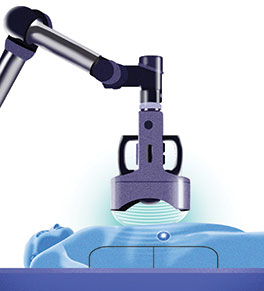Dissolving liver tumors with sound waves

A new procedure called histotripsy uses highly focused sound waves to precisely target and destroy liver tumors without damaging surrounding tissue. The noninvasive procedure involves no incisions and patients can usually go home the same day, says Dr. Nadine Abij-Jaoudeh.
Patients with inoperable liver tumors who have few other treatment options can now access a type of noninvasive ultrasound therapy at the UCI Health Chao Family Comprehensive Cancer Center. It was the first National Cancer Institute-designated comprehensive cancer center in California to offer the technology, called histotripsy.
Histotripsy uses highly focused sound waves to precisely destroy liver tumors while sparing healthy tissue in a single iutpatient procedure. Interventional radiologist Dr. Nadine Abi-Jaoudeh and her colleagues first started using the technology last fall.
“There is no incision; that is the beauty of it,” she says. “The risk of bleeding is very minimal. Patients can remain on blood thinners because we don’t have to worry about bleeding or blood clots forming like we do for other procedures.”
Histotripsy is being used to treat two types of inoperable liver malignancies: tumors that arise in the liver and those that originate in other organs, such as the colon, and spread to the liver.
Liver tumors are typically removed using surgery, thermal ablation, chemoembolization, radioembolization and stereotactic body radiation therapy for early-stage disease.
But some patients cannot undergo any of those procedures, Abi-Jaoudeh says.
That’s where histotripsy comes in. “These are patients I’m now able to treat.”
For cases involving a single lesion, histotripsy can be viewed as a potential cure, she says. For people with metastatic disease, histotripsy can extend life.
Ultrasound is widely known as an imaging system used to locate and target tumors for treatment. The new FDA-approved device, called the Edison System, uses ultrasound data to send focused sound waves into the tumor to destroy it. Patients receive general anesthesia to keep them from moving during the procedure, but most go home the same day, according to Abi-Jaoudeh.
How it works
First, a soft membrane filled with a water-based liquid is placed on the patient's abdomen. Second, diagnostic ultrasound waves precisely target the tumor's location. Next, highly focused sound waves are aimed at a single point, creating a bubble cloud that envelops and liquifies and dissolves the tumor.
Histotripsy is new and more data is needed on its long-term effectiveness, she says. A study published in September 2024 in the journal Radiology met performance goals in 95% of patients, with a low rate of major complications (7%). In the 44 cases studied, the patients had primary or metastatic liver tumors.
Abi-Jaoudeh says questions remain about whether the treatment works better on some types of cancers than others. Future studies should reveal if histotripsy is an option to remove tumors that are operable. Other studies are exploring the use of histotripsy to treat tumors in other organs.
There is definitely a learning curve,” she adds. “As researchers do studies to compare this to other modalities, histotripsy could potentially replace other treatments."
UCI Health is committed to advancing knowledge in this exciting new arena, she says. “As medicine becomes less and less invasive, this is the next frontier.
Offering these kinds of innovative therapies in a patient-centric, controlled manner puts us at the forefront,” she says. The cancer center offer patients a wide range of leading cancer treatments, as well as access to more than 500 cancer clinical trials.
“It’s important to me to give patients all the options and to explain that this is something new, and here is the data behind it,,” she says. “We look at patients in a multidisciplinary way so that they can make informed decisions.”
Read more
- Learn more about Interventional Radiology services
- Learn more about UCI Health liver cancer services




